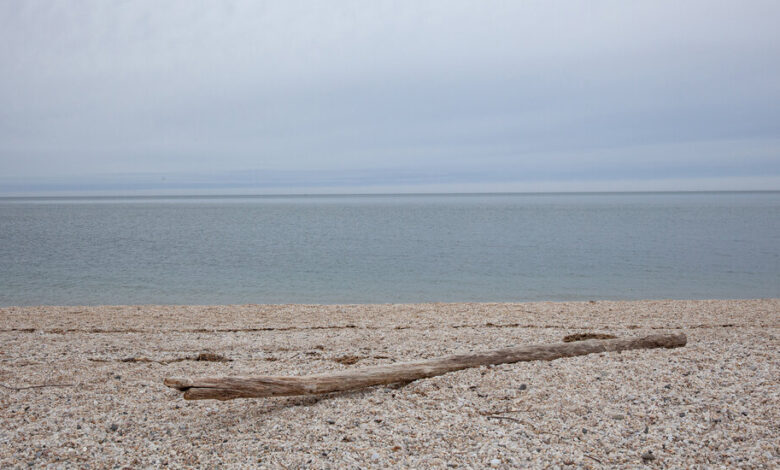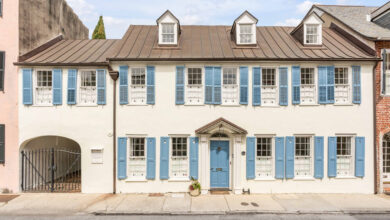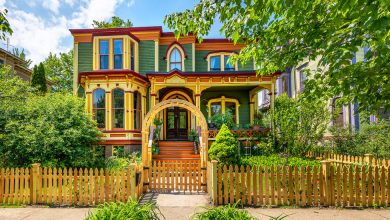Orient, N.Y.: A Historic Hamlet With a Low-Key Reputation

[ad_1]
Orient, the land’s-end hamlet on the North Fork of Long Island, usually goes quiet from November to April. Not this year. The lights were on all winter in its centuries-old waterfront village, and in the farmhouses and more suburban-style developments off Main Road.
Peter Marren, a Manhattan-based architect, began vacationing with his family in Orient more than 20 years ago, after a chance bicycle ride through farmland and along beaches that reminded him of Marin County, in California. Mr. Marren became an “accidental resident,” as he put it, when the coronavirus swept through New York. He has also found himself working locally on some renovations.
“I’m stumbling my way through the Shingle style in ‘A Field Guide to American Houses,’” he said. “People who were happy with their weekend houses are altering them now to be more permanent and complete.”
Marcia Sheldon and her partner, Lawrence Bernstein, had been house-hunting on the North Fork for some time when they heard that the owner of a 19th-century clapboard farmhouse in Orient village — the area just over the causeway separating the hamlet from mainland Long Island — had decided to sell it. As often happens in the small community, the property changed hands without ever being listed. The couple paid $1.35 million for the four-bedroom, two-and-a-half-bathroom house on a quarter of an acre, and closed in December 2019.
Ms. Sheldon, 59, a former physical therapist who is now a real estate agent, and Mr. Bernstein, who works in the nonprofit sector and had kept his place in Port Washington, soon found themselves living in Orient full time, too.
Orient village is a national historic district, built on land inhabited by Algonkians when English settlers arrived in the 17th century. Local landmark regulations restrict alterations to building exteriors dating to the 18th and 19th centuries, but interiors can be changed. The previous owner of the former blacksmith’s house that Ms. Sheldon bought had renovated it, opening up the downstairs to one big room.
“I didn’t think I’d be in the village,” Ms. Sheldon said. “But when we realized we were going to live here full time, we wanted to be in a community. We like the combination of neighborliness and privacy, and the historical aspect was a plus. I’m fine with drafty corners and uneven floorboards.”
The North Fork’s oft-noted draw as a lower-key, less populous and more affordable alternative to the South Fork had amped up considerably well before the pandemic. Still, “what people kept saying was going to happen out here never happened till Covid,” said Lori M. Feilen, a real estate agent for Town and Country who has lived and worked on the North Fork for more than 30 years. “When everyone started leaving New York, people wanted all kinds of things we don’t have much of on the North Fork — 4,000-square-foot houses, pools. But once they came, they bought.”
Another longtime local agent, Nora Conant, said that in a normal year there would be 300 to 400 listings on the North Fork during the spring. This year, said Ms. Conant, who works for Douglas Elliman, “there are 130, and a lot of them are not great listings. The pool has shrunk and the number of swimmers has increased, which leads to disappointment, unpleasantness and bidding wars.”
She counsels her buyers to have patience, expand their searches and be prepared to act fast. “Properties are coming onto the market in dribs and drabs, one or two at a time, and getting snapped up right away,” she said.
What You’ll Find
Getting to Orient involves crossing the mile-long causeway — Gardiners Bay to the south, Long Island Sound to the north — with compelling panoramas of sea and sky. Traffic waxes and wanes according to the schedule of the Cross Sound Ferry, which runs several times daily between Orient Point and New London, Conn.
The 6.1-square-mile hamlet, part of the town of Southold in Suffolk County, is home to fewer than 1,000 residents and just a handful of businesses, among them a general store, a service station, a couple of marinas and a candy shop. The nearest supermarket, bank and pharmacy are in the town of Greenport, five miles west.
Orient Beach State Park, a 363-acre finger of land that extends into Gardiners Bay and crooks back toward Shelter Island, is a destination for kayakers, cyclists, fishermen, picnickers and water birds, including ospreys, egrets and herons. Parking at smaller beaches is limited to those with Southold parking stickers.
Artists, architects, literary agents, publishing executives and writers are among the relative newcomers to Orient, living alongside farming families who have been there for generations and retirees and second-home owners from Nassau and western Suffolk counties.
In summer, many residents scan the local newspaper, The Suffolk Times, for yard sales. Farm stands flourish along Main Road. Latham’s, the biggest and busiest, opens in April with asparagus and closes in late fall after the last corn and pumpkin harvests, and also sells oysters from the beds nearby. Another farm stand offers berries in-season, picked from the fields just behind it. A flower farm offers CSA bouquets in Mason jars.
Meander along Village Lane and you’ll come upon the Oysterponds Historical Society, a museum with re-creations of rooms depicting life as it was in Orient’s earliest years, as well as a changing roster of exhibitions. Other buildings and homes along the street bear plaques recounting historical anecdotes.
What You’ll Pay
There are currently fewer than a dozen listings in Orient, and not many more in East Marion, the small hamlet just west of the causeway.
According to Zillow, the most expensive is a restored four-bedroom house in Orient village with a chef’s kitchen, a heated saltwater pool and an exercise studio, listed for $2.496 million; the least expensive is a four-bedroom, 1,560-square-foot house on Main Road next to the firehouse, priced at $749,000. In 2019, the lowest-priced house sold for $450,000.
From March 1, 2020, to mid-March 2021, 30 Orient homes sold, at an average price of $1.09 million; in the previous 12 months, 20 homes sold for an average price of $952,799, Ms. Feilen said.
Janet Markarian, of Daniel Gale Sotheby’s International Realty, said that because of Covid uncertainty, summer rentals are scarce for the coming season. “There’s a lot of wait-and-see,” she said. “Owners who usually rent their houses out in summer aren’t sure what they’re going to be doing, whether they’re going to be back in the city, or will be able to travel, or if they’ll still be here.”
For July and August, Ms. Feilen said, the price for an updated three- to five-bedroom rental home, with decks and gardens and either a pool or water frontage, has jumped to between $25,000 and $50,000 a month, up from $18,000 to $35,000 a month in previous years. Rentals without a pool or central air-conditioning go for $9,000 to $15,000 a month.
The Vibe
You’re likely to run into neighbors if you spend time porch-sitting at the Orient Country Store on Village Lane, a few doors down from the tiny post office. Miriam Foster and her husband, Grayson Murphy, took over the store 10 years ago and still stock its shelves with an eclectic mix of sundries, including Ms. Foster’s array of baked goods. The couple, both 34, have also expanded the breakfast and lunch menus.
The joke she was told when she first arrived, Ms. Foster said, was: “Orient was the place old people go to visit their parents.” Since then, she said, it has begun to skew younger, with a new generation of artisans, brewers, boatbuilders, vintners and designers living and working on the East End. Since Covid, with people working and learning remotely, more young families seem to be staying. “But it’s not for everyone,” she added. “There aren’t that many people who like rocky beaches and not much to do.”
Fourth of July weekend is an exception. The hamlet turns out for a reading of the Declaration of Independence from the porch of the 1873 Old Point Schoolhouse after a parade led by the Orient Fire Department and featuring decked-out tractors and children on bicycles festooned in red, white and blue. In 2016, Justice Sonia Sotomayor was a guest participant.
Orient residents can be as fiercely protective of their natural surroundings as they are of the area’s history. A farmland preservation program has kept hundreds of acres free from development, funded by a 2 percent transfer tax on any real estate transaction. In the early 1980s, local activists beat back a proposal for condominiums near the ferry terminal. That land is now Orient Point County Park, with views from its waterfront trail of Orient Point Lighthouse, known as the Coffee Pot.
“There’s a vigilant group that springs into action when energy is needed,” said Venetia Hands, who lives in Brown’s Hills, an enclave on a bluff above the Sound, and is a past president of the Orient Association. The group addresses challenges posed by development to the area’s ecosystem, including the limited water supply (houses are dependent on wells), as well as issues like affordable housing for the local work force and limits on building size.
The Schools
Oysterponds Elementary School, serving Orient and East Marion, runs from prekindergarten through sixth grade. In 2019, the most recent year for which statistics were reported, 81 students were enrolled. In assessment tests that year, 44 percent of sixth graders met proficiency levels in English language arts and 29 met proficiency levels in math. (Statewide proficiency levels the same year, for third- through eighth-grade students, were 45.4 percent and 46.7 percent.)
Students move to Greenport High School for seventh through 12th grade. In spring 2019, the high school’s graduation rate was 60 percent, compared with a statewide rate of 83 percent.
The Commute
The 101-mile drive from Midtown Manhattan to Orient can take anywhere between about two and four hours, depending on traffic. The closest stop on the Long Island Rail Road is in Greenport, six miles west. Fares for the roughly three-hour ride range from $15.25 to $37. The Hampton Jitney stops at Orient Village and Orient Point twice daily on weekdays, more often on weekends and in the summer, and starts at $24 for a prepaid ticket.
The History
Orient’s beauty and seclusion have been imperiled periodically by the specter of a bridge from Orient Point to New England. The idea was first raised in the 1930s and has surfaced as recently as 2018. The plan seemed to have the most oomph in the 1960s, when it was seen as a solution to easing traffic in New York City and increasing development in Suffolk County. The 25-mile span was to be an island-hopping combination of suspension bridges and causeways over Plum Island, Great Gull Island and Fishers Island, to a terminus somewhere along the Connecticut-Rhode Island coast. An extension of the Long Island Expressway from Riverhead to Orient was a key element of the plan.
For weekly email updates on residential real estate news, sign up here. Follow us on Twitter: @nytrealestate.
[ad_2]
Source link






